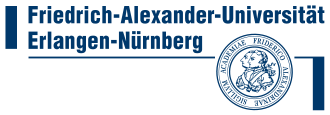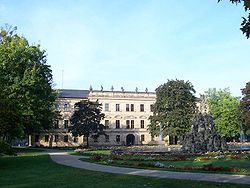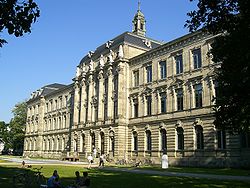| Friedrich-Alexander-University, Erlangen-Nuremberg |
| Friedrich-Alexander-Universität Erlangen-Nürnberg |

Logo of the University of Erlangen-Nürnberg |
| 建立于 |
1742 (first)
1743 (moved) |
| 类型 |
Public |
| Rector |
Prof. Dr. rer. pol. Karl-Dieter Grüske |
| 学生 |
27,299 |
| 位置 |
Erlangen and Nuremberg, Bavaria, Germany |
| 网址 |
http://www.uni-erlangen.de |

The castle in the center of Erlangen, known to many simply as the Schloss, is home to a large part of the university's administration

The Kollegienhaus, the historical central building and lecture hall of the University at the borders of the Schlossgarten
The University of Erlangen Nuremberg (German: Friedrich-Alexander-Universität Erlangen-Nürnberg or FAU) a university in the cities of Erlangen and Nuremberg in Bavaria, Germany. It is the second largest state university in Bavaria, having five Schools, 265 chairs, and 12,000 employees. There are 27,299 students enrolled (winter semester 2009/2010) at the university, of which about 2/3 are in Erlangen and 1/3 in Nuremberg. There are about 2,500 foreign students.
历史
The university was founded in 1742 in Bayreuth by Frederick, Margrave of Brandenburg-Bayreuth, and moved to Erlangen in 1743. Christian Frederick Charles Alexander, Margrave of Brandenburg-Ansbach (one of the two namesakes of the institution) provided significant support to the early university.
From the beginning, the university was a Protestant institution, but it slowly secularized. During the Nazi era, the university was one of the first that had a majority of Nazi supporters in the student council. In 1961 the business college in Nuremberg was merged with the university in Erlangen, which led to the present state of a university divided between two towns. A technical faculty was inaugurated in 1966 and the pedagogical college in Nuremberg became part of the university in 1972.
Schools
In February 2007 the senate of the university decided upon a restructuring into five faculties [1]. Since October 2007 the FAU consists of:
- School of Humanities and Social Sciences, School of Theology
- Law School, School of Business and Economics
- Medical School
- School of Sciences
- School of engineering
The following faculties were part of the university: (sorted in the order in which they were founded)
- Theological faculty
- Law faculty
- Medical faculty
- Philosophical faculty I (philosophy, history, and social sciences)
- Philosophical Faculty II (languages and literature)
- Science faculty I (mathematics and physics)
- Science faculty II (biology, chemistry, and pharmaceutics)
- Science faculty III (geography, geology / mineralogy /paleontology)
- Business- and social sciences faculty (1961) in Nuremberg
- Technical Faculty (1966)
- Pedagogical faculty (1972) in Nuremberg
Points of interest
- Botanischer Garten Erlangen, the university's botanical garden
Famous students and graduates
- Johann Christian Daniel von Schreber (1739–1810), naturalist, studied mammals.
- Samuel Hahnemann (1755-1843), founder of homeopathy
- Georg Simon Ohm (1789–1854), physicist, Ohm's law, named after him.
- Justus von Liebig (1803–1873), chemist, "father of the fertilizer industry".
- Ludwig Andreas Feuerbach (1804–1872), philosopher, associated with the Young Hegelians, an atheist.
- Eduard Buchner (1860-1917), chemist, Nobel Prize in Chemistry 1907
- Emmy Noether (1882–1935), mathematician, Noether's theorem, named after her.
- Hans Geiger (1882-1945), physicist, Geiger counter
- Ludwig Erhard (1897-1977), Chancellor of Germany 1963-1966
- Karlheinz Brandenburg (1954–), audio engineer, developer of the MP3 audio codec.
External links
- Official Site of Friedrich Alexander University
- Official Site -- English version
- Complete Lecture Guide
- The university library
- Alumni Network and Faculty Association of the WiSo Nuremberg
- Collegium Alexandrinum public lecture courses
- Top Industrial Managers for Europe
更多
|
|



